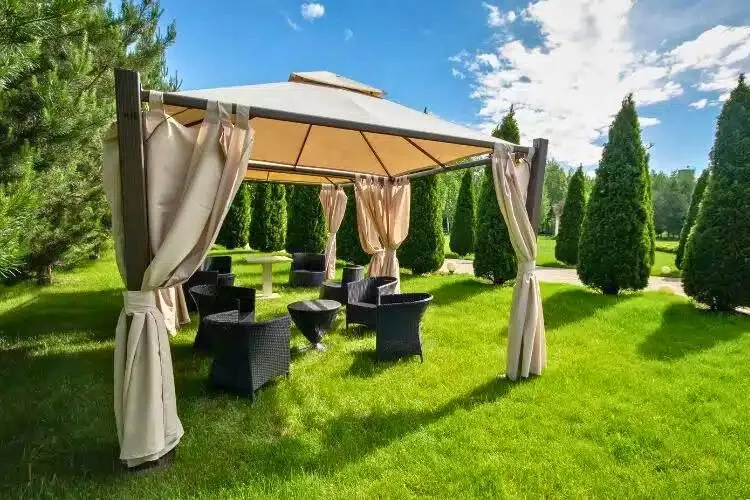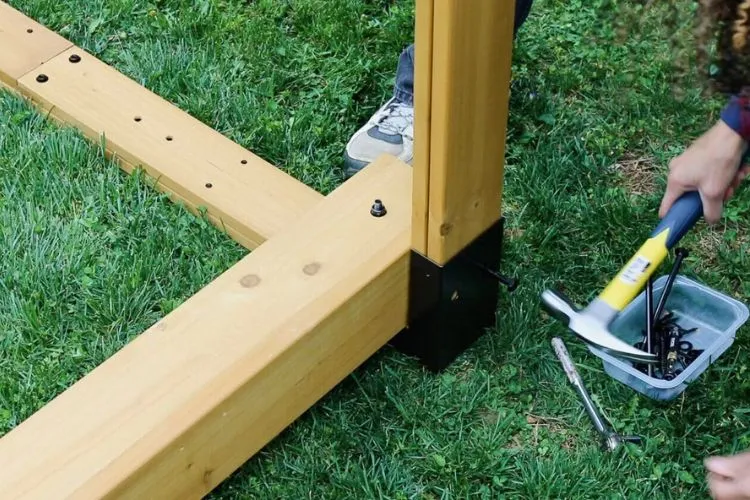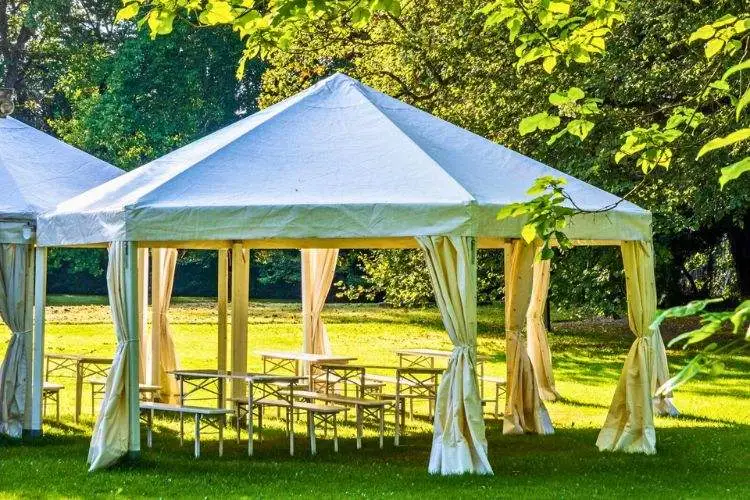Gazebos are a wonderful addition to any backyard, providing a comfortable and stylish place to entertain guests or relax with family members.
But, can you put a gazebo on grass? Can it be done without damaging the lawn or risking the stability and safety of the structure?
In this article, we’ll provide a complete guide and answer some of the frequently asked questions about putting a gazebo on grass.

Contents
- 1 Can You Put A Gazebo On Grass? Is It Possible?
- 2 Factors to Consider Before Setting Up a Gazebo on Grass
- 3 Step-by-Step Guide to Setting Up A Gazebo on Grass
- 4 Tips for Ensuring Stability and Longevity
- 5 Frequently Asked Questions (FAQs)
Can You Put A Gazebo On Grass? Is It Possible?
The short answer to this question is “yes.” It’s definitely possible to put a gazebo on grass, as long as you take certain precautions and follow some basic guidelines for stability and safety.
However, there are some factors to consider and steps to take in order to ensure that your gazebo is anchored securely and doesn’t cause any damage or harm.
Factors to Consider Before Setting Up a Gazebo on Grass
Before installing a gazebo on your lawn, there are a few important factors to keep in mind. These include the size and weight of the gazebo, the type of grass and soil condition, and the climate and weather in your area.

Size and Weight of the Gazebo
One of the first things to consider when setting up a gazebo on grass is its size and weight. Larger and heavier gazebos may have additional challenges when it comes to stability and anchoring, as the weight is more likely to cause the gazebo to sink or tilt.
It’s important to choose a gazebo that is appropriate for your lawn size and able to handle the weight of any furniture, fixtures or people that may be inside it.
Type of Grass and Soil Condition
Another important factor to consider is the type of grass and soil condition in your lawn. Certain types of grass may not be as sturdy or resilient as others, which means that installing a gazebo could cause some damage or harm.
Additionally, soil that is too soft or loose can also lead to instability or even sinking, causing the gazebo to tilt or tip over.
Climate and Weather Considerations
Lastly, the climate and weather in your area may also play a role in how you install your gazebo on grass. Areas with high winds, heavy rainfall or even snow may require additional anchors or stabilizers in order to keep the gazebo secure and safe.
Anchoring Methods for Gazebos on Grass
Once you’ve considered the factors above and have chosen a gazebo for your backyard, the next step is to anchor it securely to the grass.
There are several different methods for anchoring gazebos on grass, including concrete footings, ground screws or stakes, and sandbags or weighted anchors.
Concrete Footings
Concrete footings are one of the most secure and stable methods for anchoring a gazebo on grass.
This method involves digging holes in the ground and pouring concrete into them, then attaching the gazebo supports to the concrete footings with bolts or screws.
This method requires some expertise and equipment and may also take more time and effort to complete.
Ground Screws or Stakes
Ground screws or stakes are a simple and effective method for anchoring a gazebo on grass – as long as the ground is not too hard or rocky.
This method involves screwing or hammering metal stakes or screws into the soil, then attaching the gazebo supports to the stakes with bolts or screws.
This method is usually quicker and easier than concrete footings, but may not be as stable or secure in high winds or harsh weather.
Sandbags or Weighted Anchors
Sandbags or weighted anchors are another method for securing a gazebo on grass, particularly for temporary setups or smaller gazebos.
This method involves filling sandbags or weighted anchors with sand, rocks or other heavy materials, then suspending them from the gazebo supports with ropes or hooks.
This method is affordable and easy to install, but may not be as secure or stable in harsh weather conditions or over long periods of time.
Step-by-Step Guide to Setting Up A Gazebo on Grass
Now that you know some of the factors to consider and anchoring methods available, it’s time to get into the step-by-step process of setting up a gazebo on grass.
Following these simple guidelines will help ensure that your gazebo is anchored securely and safely.

Preparing the Location and Clearing the Area
The first step is to prepare the location where you want to install the gazebo. This involves clearing the area of any debris, rocks or other obstacles that could interfere with the anchoring process.
You should also consider leveling the area as much as possible, using a lawn roller, rakes or other tools to even out the grass and soil.
Installing the Anchoring System
The next step is to install the anchoring system that you’ve chosen. If you’re using concrete footings, you’ll need to dig the holes for the footings and let the concrete set before attaching the gazebo supports.
If you’re using ground screws or stakes, you can simply screw or hammer them into the soil and attach the supports. If you’re using sandbags or weighted anchors, you’ll need to fill them with heavy materials and suspend them from the gazebo supports.
Assembling the Gazebo Structure
Once the anchoring system is in place and secure, you can move on to assembling the gazebo structure.
Depending on the type and size of the gazebo, this may involve attaching poles, frames, and roof panels according to the manufacturer’s instructions. Make sure to double-check that all the bolts and screws are tightened securely.
Securing the Gazebo to the Anchors
The final step is to secure the gazebo to the anchors that you’ve installed. This involves attaching the gazebo supports to the anchors using bolts, screws, or ropes.
Make sure to double-check that everything is attached securely and that the gazebo is level and stable. You should also consider adding additional reinforcements or anchor points if necessary.
Tips for Ensuring Stability and Longevity
Once you’ve set up your gazebo on grass, there are some additional tips and considerations to keep in mind in order to ensure that it remains stable and lasts for years to come.
These include regular maintenance and inspections, reinforcing weak points or adding additional anchor points, and protecting the gazebo from extreme weather conditions.

Regular Maintenance and Inspections
Just like any other outdoor structure, your gazebo will require regular maintenance and inspections in order to stay in good condition.
This includes checking for any signs of wear and tear, replacing any damaged or worn-out parts, and tightening all the bolts and screws as needed.
You should also consider applying a protective coating or sealant to the gazebo wood or metal to prevent rust or decay.
Reinforcing Weak Points or Adding Additional Anchors
If you notice any weak points or areas that are tilting or sagging, consider reinforcing them with additional supports or anchors.
This can include adding cross-braces, braces, or support beams to the gazebo frame, or even installing additional anchoring systems in areas where the wind or weather is particularly strong.
Protecting the Gazebo from Extreme Weather Conditions
Lastly, be sure to protect your gazebo from extreme weather conditions, such as heavy rainfall or snow, high winds or extreme heat.
You can do this by using tarps or covers to shield the gazebo from direct exposure, or even by removing the gazebo structures entirely during particularly harsh weather conditions.
Frequently Asked Questions (FAQs)
Can I Put a Gazebo on Artificial Grass?
Yes. A gazebo can be installed on artificial grass, just like on natural grass. However, you may need to take additional steps to ensure that the artificial grass is strong enough to support the weight of the gazebo, such as installing a sublayer of plywood or concrete underneath the artificial turf.
How Can I Secure a Semi-Permanent Gazebo in Grass?
Semi-permanent gazebos can be secured in grass using any of the anchoring methods listed above, including concrete footings, ground screws or stakes, and sandbags or weighted anchors. The method you choose will depend on the size and weight of the gazebo, as well as your own personal preferences and expertise.
What Types of Flooring are Suitable for a Gazebo on Grass?
Typically, the grass underneath the gazebo will serve as the flooring. However, if you want to install additional flooring, you could consider using a temporary surface such as outdoor carpet, interlocking tiles, or even plywood sheets.
Can I Put a Gazebo on Grass Without Instructions?
While it is possible to install a gazebo on grass without instructions, it’s highly recommended that you use the manufacturer’s instructions as a guide. This will ensure that you install the gazebo correctly and safely, and that you don’t damage any of the parts or structures in the process.
Common Mistakes to Avoid When Installing a Gazebo on Grass
While setting up a gazebo on grass can be straightforward, there are a few common mistakes that can compromise the stability of your structure or lead to damage over time.
Understanding and avoiding these mistakes will ensure that your gazebo remains safe and secure.
Ignoring the Importance of Proper Anchoring
One of the biggest mistakes people make when installing a gazebo on grass is neglecting proper anchoring. Without secure anchors, your gazebo may shift, lean, or even collapse, especially in windy conditions.
Always ensure that your gazebo is firmly anchored, even if you’re using temporary methods like sandbags or stakes. For more permanent setups, concrete footings or ground screws are essential for stability.
Choosing the Wrong Type of Anchoring Method
Another common error is selecting an inappropriate anchoring method for the type of gazebo or ground conditions. For instance, using sandbags for a large, heavy gazebo is not ideal, as they may not provide enough stability.
Similarly, ground screws may not be effective on hard or rocky soil. Always consider the weight and size of your gazebo, as well as the ground conditions, before selecting an anchoring method.
Skipping the Preparation of the Ground
Before installing your gazebo, it’s crucial to properly prepare the ground. Many people skip this step, which can lead to uneven surfaces, potential damage to the lawn, or instability.
Ensure the area is free of rocks, roots, and debris. Leveling the ground and ensuring proper drainage is also essential to prevent the gazebo from tilting over time.
Overlooking Weather Conditions
Some people set up their gazebos without considering local weather conditions. If you live in an area with high winds, heavy rain, or snow, you may need extra precautions, such as additional supports or reinforcements, to ensure that the structure can withstand these conditions.
Always check weather forecasts and reinforce your gazebo accordingly.
Conclusion:
Setting up a gazebo on grass may seem daunting at first, but by following these simple guidelines and taking the time to choose the right gazebo, anchoring system, and maintenance plan, you can create a beautiful and functional outdoor space in your lawn.
Remember to consider the size and weight of your gazebo, the type of grass and soil condition in your lawn, and the climate and weather in your area.
By taking these factors into account and following the step-by-step guide above, you’ll be able to enjoy your gazebo for years to come.

Sergio Gomes, a passionate advocate for outdoor living and the male voice behind Shades Authority. With years of experience, Sergio is your trusted source for expert insights on gazebos, pavilions, cabanas, pergolas, and all things outdoor shade solutions. Join him on a journey to transform your outdoor spaces into stunning, functional retreats
